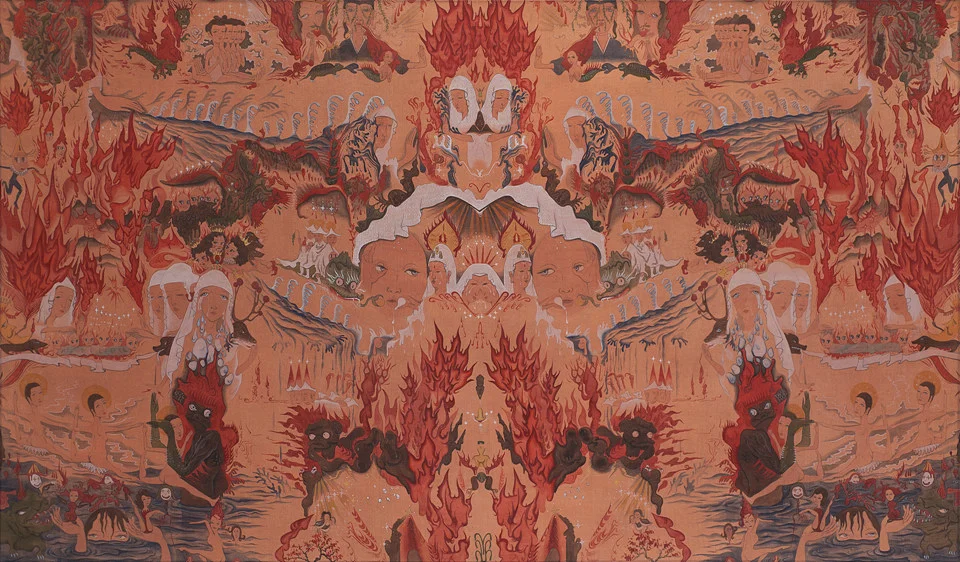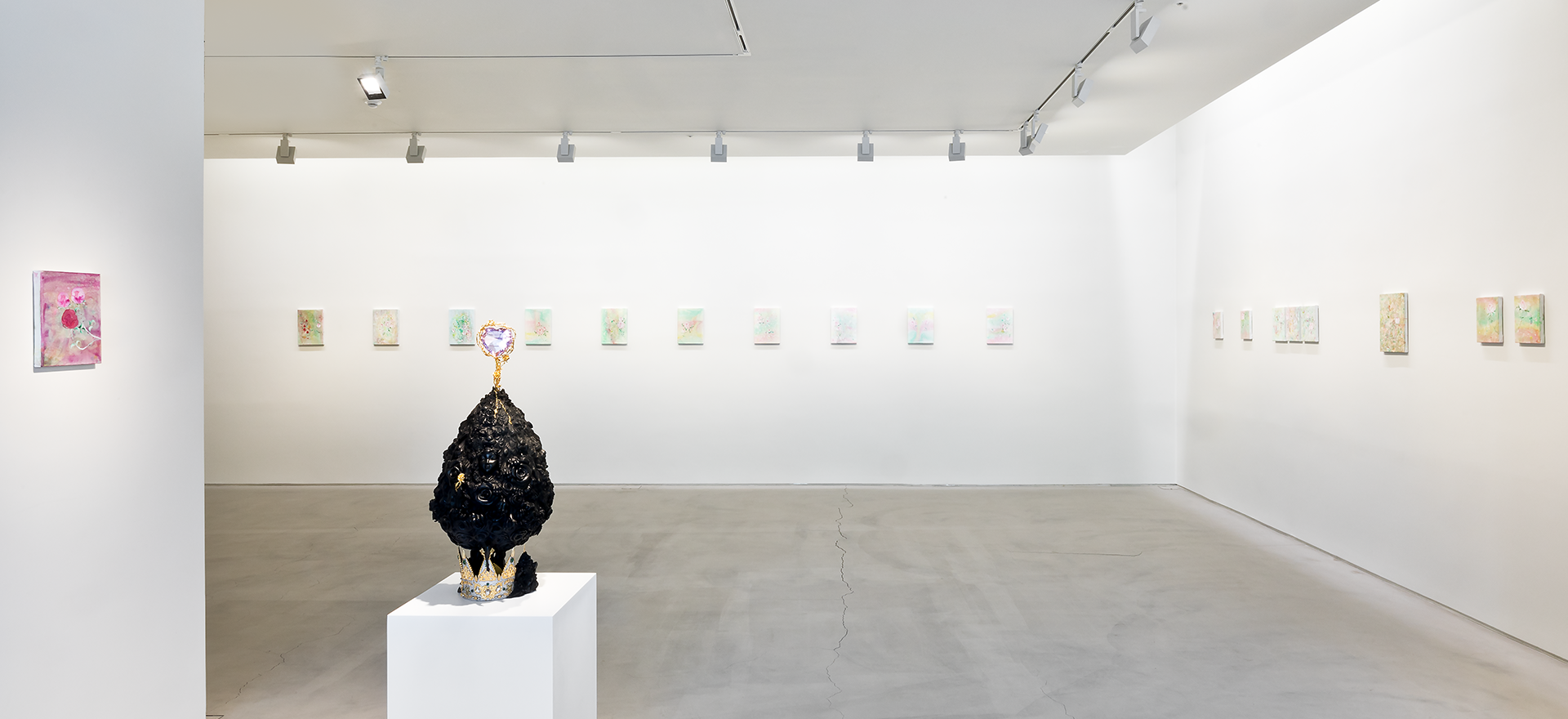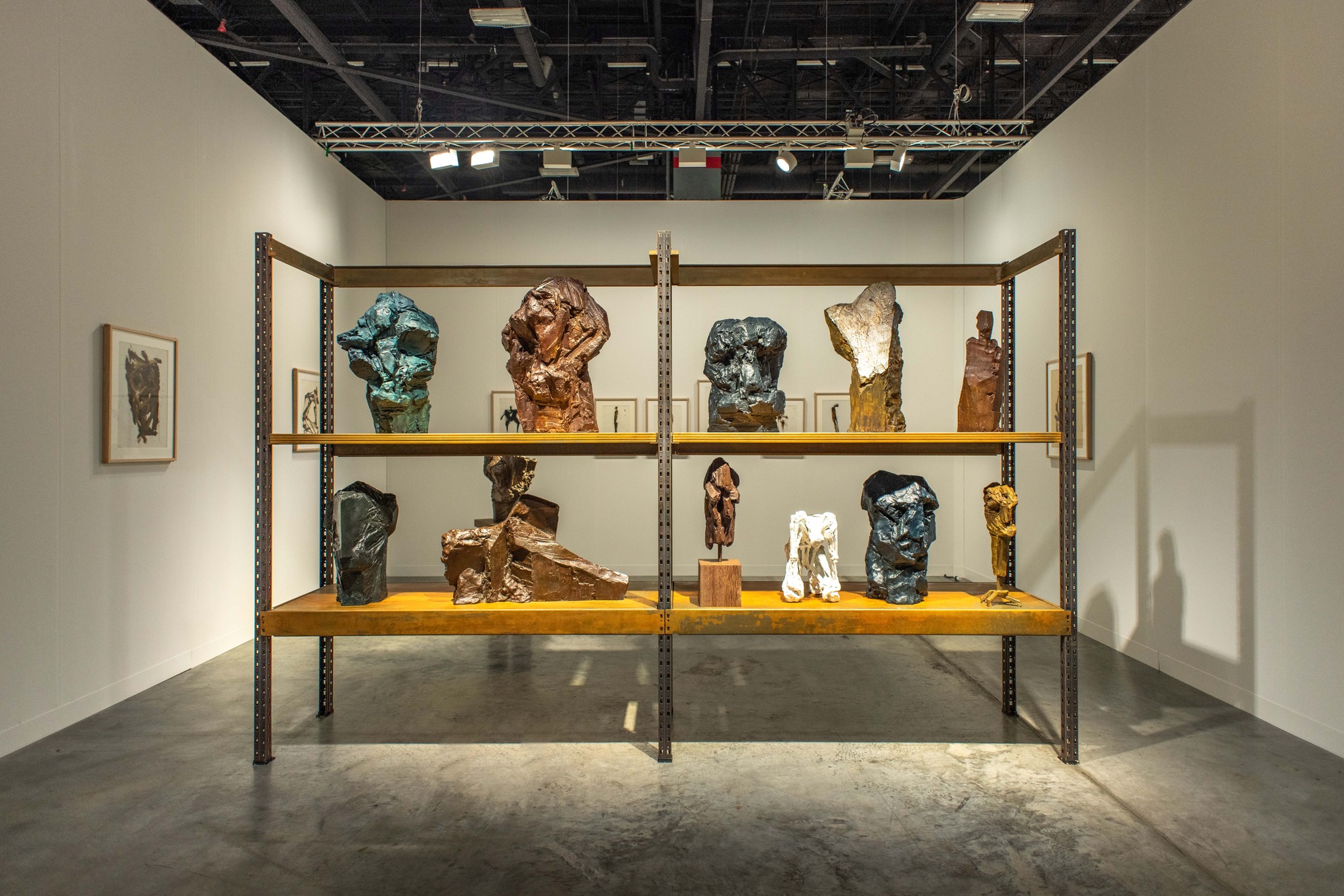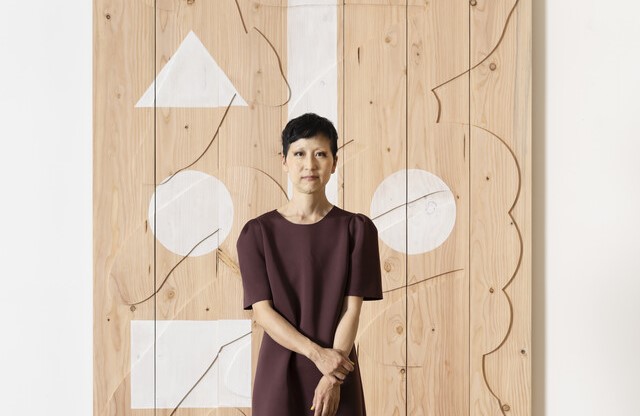Yeesookyung (b. 1963) has worked
across a diverse range of mediums, including painting, installation, sculpture,
performance, video, and drawing, all of which encapsulate historical and
cultural contexts. She has established her own world of art while exploring the
themes of the fundamental questions we have such as the past and present; life
and death; reality and unreality; secular or sacred things; individuals and
others; society and systems, and cultures of different countries.
Through her work, the artist has
translated the fundamental differences that have existed throughout human
history across various mediums, creating a broad spectrum of expression.
Additionally, she has engaged with audiences by presenting works that emphasize
the curing and regenerative functions of art.
 Yeesookyung, Artist
Uniform 2000, 2000 ©Yeesookyung
Yeesookyung, Artist
Uniform 2000, 2000 ©YeesookyungIn the early 1990s, Yee primarily
created works employing post-modern methodologies such as kitsch, ready-made,
and pastiche, critiquing the purity, originality, and self-referentiality of
modernism. She also explored works that subverted the conventional norms
produced by mass media and social institutions by appropriating or altering
mass-produced goods and media images.
In her 2000 performance work, Artist
Uniform 2000, she experimented with individual behavior within social
institutions using deconstructed and reassembled ready-made uniforms such as
police and medical attire. She disassembled six types of Korean uniforms and
categorized their parts by sleeve, pant shape, fabric type, and color. She then
surveyed around 200 artists to select parts that they felt would best suit Artist
Uniform 2000. As a result, 70 unique uniforms were created, and 70
individuals wearing these uniforms attended an exhibition opening, performing
behaviors they deemed most fitting for their chosen uniforms.

Yeesookyung, Flame, 2005-ongoing ©Yeesookyung
Around 2004, while undergoing
psychological counseling, Yeesookyung learned about the “mandala art therapy”
technique, which involves drawing images within a circle daily. Incorporating
this method into her practice, she began to create drawings as a healing
process. Among these works is the ‘Flame’ series (2005–), in which the
artist, much like Buddhist monks who focus intensely until reaching
enlightenment, continually asked herself the single question, “What is a
flame?”
Using cinnabar—a commonly used material in Korea,
Japan, and China, mainly for talisman or Buddhist paintings—she meticulously
painted repetitive patterns on hanji (traditional Korean paper) at the same
time each day, treating the process as a meditative ritual. Yee described how,
in creating the ‘Flame’ series, she experienced moments where her brush
seemed to move automatically, producing images that appeared as if they were
drawn independently of her conscious control.
 Yeesookyung, Flame
Variation 1-1, 2012 ©Yeesookyung
Yeesookyung, Flame
Variation 1-1, 2012 ©YeesookyungIn 2012, she selected parts of her ‘Flame’ drawings and, using digital software, mirrored these images to create symmetrical compositions. These digitally manipulated images were then used to produce the ‘Flame Variation’ series, following the strict methods of creating Buddhist altar paintings.
 Yeesookyung, Past
Life Regression Painting - Tutangcla, a Warrior Murdered by the Spanish Troops,
2014 ©Yeesookyung
Yeesookyung, Past
Life Regression Painting - Tutangcla, a Warrior Murdered by the Spanish Troops,
2014 ©YeesookyungIn 2014,
after experiencing past life regression through hypnotherapy, the artist began
exploring the themes of reincarnation and past lives—key concepts in East Asian
philosophy—through her personal experiences in her ‘Past Life Regression
Painting’ series (2014–). This series can be seen as a journey into the
artist's unconscious and a time travel into her past.
The
theme of "travel," which traverses the realms of reality and
unreality, as well as the present and the past, has been present in Lee’s work
since her 1997 children's book, 「Story of MunKil
(long journey) 」. A common
thread in her works involving travel is the process of the subject encountering
others along the journey, leading to a new self-awareness, inner healing, and
personal growth.

Yeesookyung, Translated Vases Albisola, 2001 ©Yeesookyung
Yeesookyung’s notable series, ‘Translated
Vase’, began with her work Translated Vases Albisola
(2001), created for the Albisola Biennale in Italy. She invited a local
ceramicist from Albisola—renowned for its ceramic tradition—to read poems about
Joseon Baekja, traditional Korean white porcelain, and craft 12 vases in the
style of 18th-century Korean white porcelains based on the images that came to
mind. Through this process, the Korean white porcelain was newly
"translated" by the Italian ceramicist.
Later, Yee personally visited the
studios of master potters, collecting discarded and broken ceramic fragments.
She meticulously pieced these shards together, gilding the cracks to transform
them into new ceramic sculptures. These fragments, sourced from various eras
and regions of Korea, including North Korean ceramics, were intertwined into a
single new form, merging the diverse contexts embedded within them.
 Yeesookyung, Translated
Vase_2017 TVBGJW 1_Nine Dragons in Wonderland, 2017 ©Yeesookyung
Yeesookyung, Translated
Vase_2017 TVBGJW 1_Nine Dragons in Wonderland, 2017 ©YeesookyungThrough her unique translation process, Yee breathes new narratives into discarded ceramic fragments, crafting them into infinitely expansive forms that are no longer fragile. For instance, Nine Dragons in Wonderland, inspired by the Chinese myth of the nine sons of the dragon—a creature revered in Korean culture—reinterprets the dragon's symbolic power by crafting it from ceramic shards, thus reconnecting the severed links between past and present.
 Installation view
of “Yeesookyung, Moonlight Crowns” ©Art Sonje Center
Installation view
of “Yeesookyung, Moonlight Crowns” ©Art Sonje CenterYeesookyung
has continually presented art that embodies tradition and modernity, along with
Eastern identity, while conveying themes of “cure” and “regeneration.”
Following her ‘Translated Vase’ series, which involved connecting
ceramic fragments to create new forms, she introduced the ‘Moonlight Crowns’
series (2017–), where various craft materials were reborn into vertical
crown-like structures.
Inspired
by the forms of the Silla golden crown and the Baekje gilt-bronze incense
burner, Yee reimagined the crown—a symbol of power—by placing it as a base
rather than on top of the head, and stacking various fragments like a tower.
The pieces that make up the ‘Moonlight Crowns’, including iron, brass,
glass, pearl, mother-of-pearl, gemstones, and mirror fragments, are adorned
with patterns and figures like angels, praying hands, crosses, dragons, plants,
cartoon characters, and magic wands, reflecting diverse symbols.
Just as
the different broken pieces in the ‘Translated Vase’ series were joined
to form new shapes and beings, the ‘Moonlight Crowns’ series also
gathers fragmented materials and symbols that stray from their original
mythological and religious contexts, giving rise to new entities.
 Installation view
of “Yeesookyung, Moonlight Crowns” ©Art Sonje Center
Installation view
of “Yeesookyung, Moonlight Crowns” ©Art Sonje CenterYee's work is not only about reassembling fragile fragments into new, complete forms but also about healing her own inner self through repetitive creation and sharing that experience with others.
“I often found myself overwhelmed with indescribable joy while working. To preserve that feeling, I want to immerse myself in the process as if falling deeply in love, fully embracing my own fragility. I want to maintain an attitude and mindset that doesn’t fear being broken.” (Noblesse, Yeesookyung Interview, September 8, 2022)
 이수경 작가 ©노블레스
이수경 작가 ©노블레스Yeesookyung
has held her solo exhibitions at prominent institutions both in Korea and
internationally, including The Page Gallery in Seoul (2022), Massimo De Carlo
Gallery in London (2020), Museo di Capodimonte in Naples (2019), Asia Society
Texas Center in Houston (2015), Atelier Hermès in Seoul (2015), Daegu Art
Museum in Daegu (2015), Museum of Contemporary Art Taipei in Taiwan (2015), and
ARKO Art Center in Seoul (2010).
Yee has
also participated in numerous major international exhibitions, including those
at the Bristol Museum & Art Gallery in UK (2019), Casa Cavazzini in Udine,
Italy (2018), the 57th Venice Biennale (2017), and Maraya Art Center in
Sharjah, United Arab Emirates (2015), among others.
Yeesookyung’s
works are in the permanent collections of National Museum of Contemporary Art
in Korea, Leeum Samsung Museum of Art in Seoul, Los Angeles County Museum of
Art, in USA, Museum of Fine Arts Boston in USA, IFEMA ARCO Collection in
Madrid, Echigo-Tsumari City Collection in Japan, British Museum in London, and
Spencer Museum of Art at University of Kansas in USA, M+ Museum in Hong Kong,
among others.






















